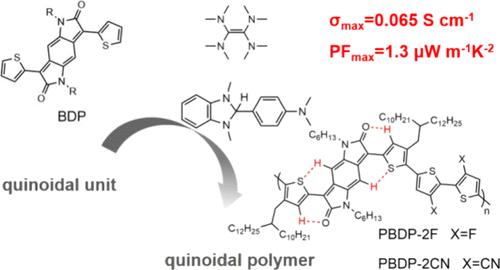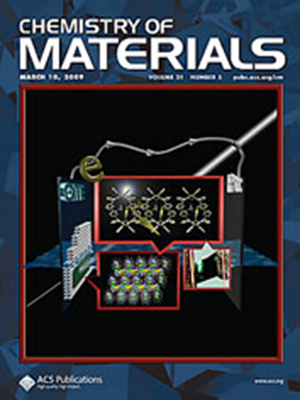基于苯并二吡咯烷酮 Quinoidal 单元的 n 型共轭聚合物的热电性能
IF 7.2
2区 材料科学
Q2 CHEMISTRY, PHYSICAL
引用次数: 0
摘要
有效的电荷传输特性和分子掺杂效率是实现高性能有机热电(OTE)的关键。然而,适用于聚合物结构的缺电子构筑嵌段非常稀缺,这是一个重大挑战。为了解决这一不足,我们首次将苯并二吡咯烷酮(BDP)引入有机热电领域。这项工作研究了两种基于 BDP 的 n 型聚合物 PBDP-2F 和 PBDP-2CN 的 n 掺杂和热电特性。值得注意的是,PBDP-2CN 的 ELUMO 值为 -4.13 eV,与 PBDP-2F 相比降低了 0.11 eV。由于 PBDP-2CN 具有较高的电子亲和性,因此比 PBDP-2F 更容易掺杂,从而获得更高的热电性能。此外,我们利用拉曼光谱进行的比较分析表明,与 P(NDI2OD-T2)相比,掺杂后的振动模式保持不变,这表明基于类醌的聚合物具有优异的结构稳定性。这一重大贡献预示着 BDP 作为构件在 OTE 中的创新应用,并为实现卓越热电性能的 n 型聚合物分子设计提供了重要启示。本文章由计算机程序翻译,如有差异,请以英文原文为准。

Thermoelectric Performance of n-Type Conjugated Polymer Based on a Quinoidal Unit of Benzodipyrrolidone
Effective charge transport properties and molecular doping efficiency are pivotal for achieving a high performance in organic thermoelectrics (OTEs). However, a significant challenge has been the scarcity of electron-deficient building blocks suitable for polymer construction. To address this shortfall, we introduce the quinoidal unit benzodipyrrolidone (BDP) into the realm of organic thermoelectrics for the first time. This work investigates the n-doping and thermoelectric properties of two BDP-based n-type polymers, PBDP-2F and PBDP-2CN. Notably, PBDP-2CN exhibited an ELUMO of −4.13 eV, representing a 0.11 eV reduction compared to PBDP-2F. Due to its high electron affinity, PBDP-2CN can be doped more easily than PBDP-2F, resulting in higher thermoelectric performance. Furthermore, our comparative analysis with Raman spectroscopy highlighted the exceptional structural stability of quinoidal-based polymers, as evidenced by the preservation of vibrational modes upon doping compared to P(NDI2OD-T2). This significant contribution heralds the innovative use of BDP as a building block in OTEs and yields crucial insights into the molecular design of n-type polymers for achieving a superior thermoelectric performance.
求助全文
通过发布文献求助,成功后即可免费获取论文全文。
去求助
来源期刊

Chemistry of Materials
工程技术-材料科学:综合
CiteScore
14.10
自引率
5.80%
发文量
929
审稿时长
1.5 months
期刊介绍:
The journal Chemistry of Materials focuses on publishing original research at the intersection of materials science and chemistry. The studies published in the journal involve chemistry as a prominent component and explore topics such as the design, synthesis, characterization, processing, understanding, and application of functional or potentially functional materials. The journal covers various areas of interest, including inorganic and organic solid-state chemistry, nanomaterials, biomaterials, thin films and polymers, and composite/hybrid materials. The journal particularly seeks papers that highlight the creation or development of innovative materials with novel optical, electrical, magnetic, catalytic, or mechanical properties. It is essential that manuscripts on these topics have a primary focus on the chemistry of materials and represent a significant advancement compared to prior research. Before external reviews are sought, submitted manuscripts undergo a review process by a minimum of two editors to ensure their appropriateness for the journal and the presence of sufficient evidence of a significant advance that will be of broad interest to the materials chemistry community.
 求助内容:
求助内容: 应助结果提醒方式:
应助结果提醒方式:


